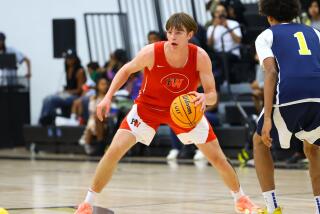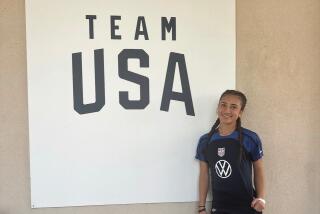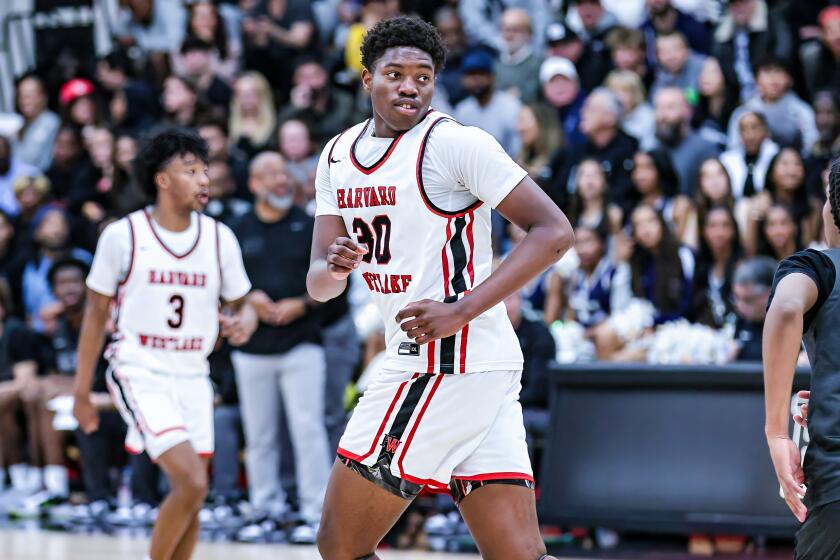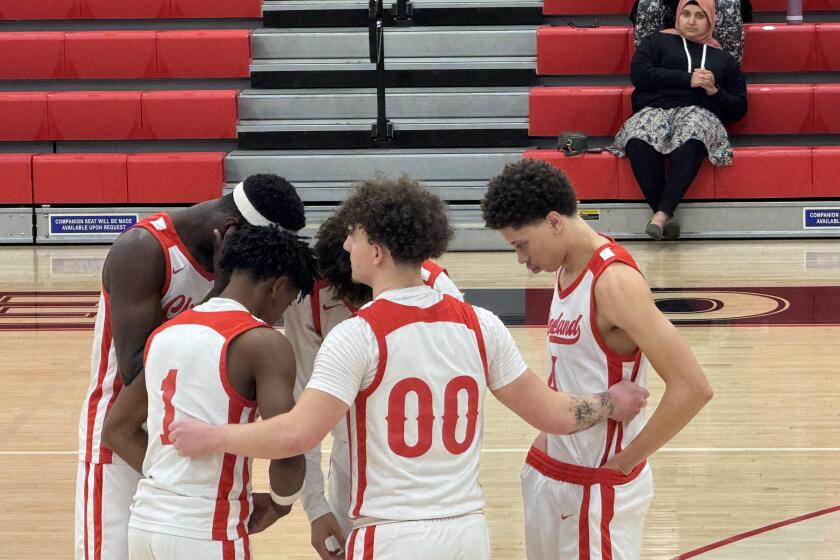Starting What They’ve Already Finished : The Real Prep Basketball Begins After School Recesses for Summer
- Share via
Sean Higgins, a highly touted 6-8 junior-to-be at Fairfax High, estimates he will have played more than 60 basketball games in six weeks this summer. That’s more than twice what he will play for Fairfax in almost three months next season.
His summer odyssey of basketball has taken him to Princeton, N. J., for the Athletes for Better Education basketball camp, to Superstars Camp in Santa Barbara, to a national prep basketball tournament in Las Vegas, and to several local tournaments with his own high school team, not to mention participation in the summer Slam ‘n’ Jam and American Roundball Corp. leagues.
But Higgins shrugs off talk of basketball burnout.
“I can’t get enough,” he said. “I love the game too much. If my body can take it, why not (play)?”
But it is more than love driving Higgins and hundreds of other Southern California high school players on a nonstop summer merry-go-round of basketball.
National reputations and scholarships to super basketball schools are at stake.
Many now perceive their performance in summer all-star games and camps against high-caliber players as the best way to achieve both.
“I’ve seen players leaving in the middle of a summer league game with their high school team to go to a game in an all-star league,” said Don Mead, who runs a basketball scouting advisory service.
“It’s not a good trend, but it is what is happening. The high school coach should be the one to have the influence with the player, but that influence has shifted to the all-star coach.”
This has not gone over well with many high school coaches, who feel authority slipping away. They don’t mind a player missing a game now and then or even going to a good camp for a week, but argue that his first and foremost loyalty should be to his school.
It used to be that way.
But that was before the Collegiate Commissioners Assn. in 1983 established an early NCAA signing period of one week in November, designed to take the recruiting pressure off the athlete during his senior year and help college coaches cut recruiting time.
The early signing period has been popular with the players, so much so that a majority of the nation’s elite now sign letters of intent before playing their first high school basketball game as a senior.
A spokesman for Eastern Basketball magazine noted that 68 of its top 100 high school prospects on the East Coast signed early rather than on the regular signing date in April of the following year.
To the dismay of many Southern California high school coaches, top players are now being judged not on what they do for their schools but on how they perform in summer all-star leagues like Issy Washington’s Slam ‘n’ Jam and Rich Goldberg’s American Roundball Corp., where college coaches congregate like flies at a picnic.
Last month four teams each from Goldberg’s and Washington’s leagues participated in a national prep tournament in Las Vegas. It was played before more than 100 major college coaches, including John Thompson of Georgetown, Lute Olson of Arizona, Gene Bartow of Alabama- Birmingham, and Stan Morrison of USC.
Before the early signing date, the tournament drew fewer and less prominent coaches.
By contrast, there are seldom more than one or two college recruiters at a regular high school summer league game.
“What’s happening is that these (off-season) leagues are tools for the major colleges because it’s a lot easier for college recruiters to see better kids all at once,” said Paul Muff, coach of Crespi High in Encino.
Said Mead: “They (the NCAA) wanted to take the recruiting pressure off the players during the school year, but what they have done is make the pressure to perform well in the summer ungodly.”
The growth of the all-star programs, spurred by the early signing period, has created problems for coaches and players.
For instance:
Should the player listen to his all-star coach or his high school coach, especially if each is telling him something different? Who can do more for him? Is it in the player’s best interest to play 60 games in the summer? Does he have to participate in all-star ball to receive that cherished scholarship?
These are perplexing problems for a 17-year-old.
But there are equally perplexing problems for many high school coaches.
Should they prohibit, or curtail, a player’s participation in a camp or all-star league and run the risk of his rebelling and leaving the school? Should they coach in the all-star leagues to make sure their players don’t receive what they sometimes consider to be poor advice and coaching? Should they get caught up in the summer basketball whirlwind, even if they feel it does more harm than good?
There are coaches who believe that the more a player competes the better he will be, and that the more skilled players he competes against the more skilled he will be. They see no harm in a player performing in all-star leagues, with the extra exposure it brings.
Carson High Coach Richard Masson sees a benefit in the marginal college prospect playing as much as he can during the summer.
“The kids--great players--playing summer ball probably won’t make a difference,” he said. “But for the marginal player, 50 games in the summer will give him a better chance at a scholarship.”
But Masson also repeats a common coach’s complaint about off-season play.
“Burnout? Hey, I’m tired of it (basketball) by the end of the summer and I’m sure they are too.”
To many coaches, more doesn’t make better. They claim that an excess of summer games, including the ones for their high schools (some schools play three or more games a week), frequently results in diminished performance, that players pick up sloppy habits at camps and all-star leagues where the emphasis is on a run-and-gun style, and that the pressure to perform well before swarms of college coaches in all-star leagues is unbearable.
Said one high school coach, who asked not to be identified: “It takes me a month to rid players of the bad habits they picked up at camps or all-star leagues. If I had my way, I wouldn’t let them participate. But if I did that, they would probably transfer to another school. The kids have been conned into believing that camps and all-star leagues are the way to go . . . that they are more important than high school play.
“That’s bull. The great player is going to get the scholarship to the big-name school whether he plays in all-star leagues or not, and no coach worth his salt is going to offer a marginal player a scholarship during the early signing period. He is going to want to see how the player performs in high school.”
Brian Capp, the Del Rey League player of the year last season at Crespi, said he was told by certain people last summer that summer play was more important than high school ball.
“They told me that in high school you play a role, but in all-star competition you have more freedom to show what you can do,” he said.
Although highly touted, Capp failed to show what he could do in summer play and did not receive a four-year offer. He will play at Glendale College this fall.
Said Mead: “What we have now is all-star coaches having influence on the kids. Many of them are not equipped to give advice. That’s why we are seeing so many transfers after the freshman year in college. The kids are taking advice from the wrong people.”
USC Coach Stan Morrison said that if it is true that the summer all-star coach has usurped the authority of the high school coach, “it’s a shame. There is a strong bond of credibility when you’re dealing with high school coaches. Some of these summer coaches are ill-equipped to give advice to the youngsters.”
Morrison said he went to one basketball camp this summer where the type of play (run and gun, with emphasis on gun) upset him so much that he left early. “I didn’t even stay around for the camp all-star game. I sometimes wonder if people know what a coach is looking for in a player.”
Morrison said he sees more poor coaching in summer all-star competition than good. “But I have seen good coaching, too. Pat Barrett did a great job of coaching the Mid-Valley team.” Mid-Valley, with Barrett and Goldberg as co-coaches, won the national tournament in Las Vegas.
“A lot of kids pick up bad habits in the summer,” added Morrison. “Some kids pick up good habits too, but that’s more rare.”
Good or bad habits notwithstanding, many high school coaches are disturbed by the pressure on the players in the summer. They feel the players should be having fun, meeting new people and having experiences outside basketball.
One player agrees. Said top prospect Jamie Cardriche, a 6-9 senior center from St. Anthony: “When you get tired you play poorly. One day I played four games. By the fourth game I didn’t care if John Thompson was watching me. I was tired.”
A Southern Section survey four years ago showed that 70% of all basketball coaches wanted to see a decline in summer activities, according to Commissioner Ray Plutko. And there were half as many games then as now.
Goldberg, whose American Roundball Corp. program is in its 11th season and includes 40 to 50 teams, does not believe most coaches want less basketball. Many coaches in his league are high school head coaches and assistants, he says.
Goldberg: “High school coaches are supportive of outside basketball.” He added that the coaches who talk about losing control of their players to all-star programs or allowing them to participate in outside leagues “have ego problems.”
Washington, whose Slam ‘n’ Jam is considered the premier league in California and one of the best in the nation, is a believer in off-season play.
The retired Air Force major started his spring-summer league in 1978 primarily for inner-city youngsters, but has seen it grow to include players from all areas. He estimates that the league handles 250 players each summer and that he has turned away 200 to 300 more.
“I’d rather have them (players) on the courts than in the courts,” he said. “Kids should do what they want to do. No one forces them to do this.”
But some high school coaches believe there is pressure to play, and that players feel they have to do it or lose the competitive edge to those who do.
There is the same type of pressure on high school coaches.
“During the summer there should be a limit (on the number of games played),” said Bosco Tech Coach Jorge Calienes. “But if you want to be good, you’ve got to keep up with the Joneses, otherwise the other teams will be better than you. It’s a matter of keeping up.”
Since he began coaching off-season basketball, Long Beach Poly Coach Chris Kinder has kept a record of the miles he drives to off-season basketball games from the time school ends in June until it begins in September. Through the middle of July, Kinder had logged 1,410 miles.
“And that’s not even going to see other games. That’s just showing up for my stuff,” he said. Kinder claims coaches often must help players by supplying gas money and picking up the tab for meals after games.
It’s that kind of personal sacrifice that has many coaches asking when it will stop.
Said St. Anthony Coach Danny Marques: “It’s getting out of hand. We probably play more summer games than regular season games. I’m burnt. The kids are burnt. It’s an awful long summer.”
Marques, who guided the Saints into the 5-A quarterfinal playoffs last year against Kinder’s Jackrabbits, was all-league at St. Anthony in 1973. He remembers the days when summers were free.
“We played once a week. There were no superstars, Slam ‘n’ Jam or Olympic Development leagues, nothing,” he said. “This is something that has happened in recent years and it’s getting out of hand.”
Opponents of non-school basketball would like to see restrictions on the number of activities for each player. But who would enforce it?
Kinder suggests that a solution will come when coaches decide enough is enough.
“I don’t know if the CIF is the answer,” he said. “It’s not really its responsibility to legislate during the summer. If the coaches say yes, we will (cut back). If no, we won’t. He (the coach) has the influence over his kids. Do you want to play 25 games or 10?”
But Washington reacts angrily to suggestions that controls are needed.
“Why should they?” he says in response to a suggestion that Southern Section offices restrict off-season play. “You want Big Brother? What is this, Russia? I spent 20 years in the military to stop that.”
“It’s a double-edged sword,” said Carson’s Masson of off-season play. On the one hand there is burnout, but on the other there is the chance for each player to reach his potential.
More to Read
Get our high school sports newsletter
Prep Rally is devoted to the SoCal high school sports experience, bringing you scores, stories and a behind-the-scenes look at what makes prep sports so popular.
You may occasionally receive promotional content from the Los Angeles Times.






